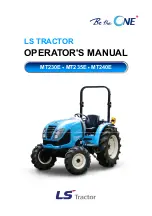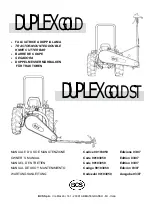
OPERATIONAL CONTROLS
Operation - 24
Foot Pedal (L)
2
2
1
1
1. Reverse Direction
2. Forward Direction
The foot pedal works in conjunction with the SDLA
control lever and can be used to control the speed
and direction of the power unit when the operator’s
hand is removed from the SDLA lever.
Press down on the front portion of the foot pedal to
move the power unit in the forward direction. Press
down on the rear portion of the foot pedal to move
the power unit in the reverse direction. Changing the
amount the foot pedal is depressed will immediately
change the ground speed of the power unit.
To slow or stop (brake) the power unit, press down
on the opposite portion of the foot pedal (i.e. if you
are traveling forward, press down on the rear por-
tion of the foot pedal).
Selector Lever/Parking Brake(M)
When parking the
1. Park Brake
2. Neutral Assist (auto)
3. Neutral Assist Off
1
1
2
2
3
3
power unit, always
move the selector
lever to the park-
ing brake position (1) to prevent
accidental movement of the machine.
To engage the parking brake,
pull the selector lever back
toward the operator.
If the operator leaves the seat without
first setting the parking brake, the
power unit will shut off the engine. The
foot pedal and the SDLA control lever
are locked from forward or reverse movement when
the selector lever is in the parking brake position.
Placing the selector lever in the neutral assist (auto)
position (2) engages the neutral assist spring to help
return the SDLA control levers to the neutral position.
This makes the neutral position easy to select and
maintain. The neutral assist (auto) position is recom-
mended when learning the operation of the power
unit, loading or unloading, attaching and removing
attachments, and whenever the operator is unsure of
the power unit’s response to the task being performed.
Placing the selector lever in the neutral assist off
position (3) disengages the neutral assist spring. This
position is designed for experienced operators when
using the power unit in open areas where travel
speed and direction are relatively constant and
control is easily maintained. The neutral assist off
position reduces operator arm fatigue when using the
power unit for prolonged periods of time.
CAUTION
Stopping the power unit with the neutral assist
lever in the off position requires the operator to
manually return the SDLA control lever or foot
pedal to the neutral position.
Auxiliary Hydraulic Quick Couplers (N)
The two couplers are a part of the auxiliary hydrau-
lic circuit and are used with an attachment which
requires hydraulics (e.g. to angle a dozer blade or
rotate the discharge on the snow blower).
Power Take Off (PTO) Switch (O)
Pulling up on the PTO switch
1
1
0
0
0. PTO Off
1. PTO On
engages the electric clutch to provide
power to the front attachment.
Pushing down on the PTO switch
disengages the electric clutch and
applies the clutch brake to stop the
attachment. NOTE: the PTO will turn
off automatically if the operator leaves
the seat. The PTO can be restarted by
turning the PTO switch off and then on again.
Headlight Switch (P)
Pressing the front (1) of the head
0
0
1
1
0. Off
1. On
light switch turns the headlights and
taillights on. Pressing the back (0) of the
switch turns the lights off.
Throttle Lever (Q)
1
1
2
2
1. Slow
2. Fast
Moving the throttle lever forward toward the fast posi-
tion (1) increases the engine Revolutions Per Minute
(RPM). Moving the throttle lever backward toward the
slow position (2) decreases the engine RPM.
Choke Lever (R)
Move the choke lever
Choke On
Choke On
(Start)
(Start)
Choke Off
Choke Off
(Run)
(Run)
forward to aid in starting
a cold engine. Move the
choke lever to the back
for operation.
















































